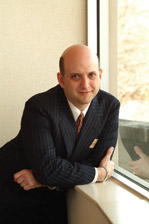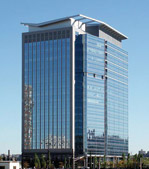|
COVER STORY, SEPTEMBER 2005
AMERICAN FINANCIAL TRUSTS IN NEW REIT BUSINESS MODEL
Pennsylvania-based American Financial Realty Trust is finding tremendous growth by focusing on financial institution tenants.
Nicole Thompson
There is a real estate investment trust (REIT) for almost every aspect of real estate — such as sector-based REITs that focus on a type of property like office projects, or geographically focused REITs that might only own properties in one particular region. But Jenkintown, Pennsylvania-based American Financial Realty Trust (NYSE: AFR) is employing a new model when it comes to REITs by focusing on a single tenant sector. AFR, which was formed as a REIT in May 2002 and had one of the largest domestic IPOs of 2003, has seen astounding asset growth over its history by targeting tenants in the regulated financial services industry and establishing multifunctional relationships with them by leasing, often on a net basis, office buildings, bank branches, operational centers — any real estate that a financial company requires is AFR’s specialty.
 |
Amercian Financial Realty Trust President and CEO Nicholas Schorsch
|
|
The company’s assets have grown quickly as AFR acquires more portfolios and deepens its relationships with financial institutions.
“These are very large transactions, with very serious people,” says Nicholas Schorsch, the president and CEO of AFR who founded the company with his wife Shelley. “These institutions are looking for long-term stability and long-term landlords — they’re looking for somebody that is going to be their partner in the future.”
In the second quarter alone, AFR had acquired 158 properties comprising an aggregate of approximately 4.2 million square feet with a total purchase price of approximately $281.1 million, bringing the company’s building ownership or leasehold interest to more than 1,000 properties comprising approximately 36.5 million square feet in 38 states and Washington, D.C.
AFR has made several acquisitions since the end of the second quarter.
In July, AFR completed the $24.5 million acquisition of a 158,000-square-foot credit card operations center in Sioux Falls, North Dakota, that is net-leased to a subsidiary of HSBC through November 2013.
In early August, AFR completed another large acquisition, the national headquarters of the Fireman’s Fund Insurance Company in Novato, California, which is a three-building Class A office portfolio with more than 700,000 square feet over 64 acres. The gross purchase price for the property was approximately $283.5 million. Fireman’s Fund will continue to lease 100 percent of the property on a net-lease basis through November 2018.
This rapid acquisition pace has been funded in several different ways, including through public offerings, the most recent in May, which resulted in net proceeds of approximately $242.6 million. The company watches its leverage and equity ratios, however.
“We wanted to balance our overall balance sheet with a long-term strategy that kept our leverage ratios and our equity ratios in good stead,” says Schorsch of the offering. “And with our acquisition pipeline as strong as it was, we basically only raised money for the acquisitions that we were closing, and Fireman’s Fund just finishes that whole package off. So it’s pretty amazing that in less than 18 weeks, we took down $250 million and fully deployed all of it — that’s the game, that’s the whole point of the business. We told the market that we would not raise money that we could not put to work promptly.”
AFR is also careful to dispose of non-core assets and preserve the business model. In the first half of 2005, the company sold a total of 67 properties and disposed of four leasehold interests, about 1.4 million square feet total, of which approximately 925,000 square feet was vacant or expected to become vacant in the near term. These dispositions resulted in an approximately $3.8 million net gain (net of impairments and income tax).
“We’re very keen to make sure that we dispose of assets that are not core to us because one, they have large vacancy, or two, they do not have occupancy of a financial institution of greater than 25 to 35 percent of the asset,” says Schorsch.
The company has grown by leaps and bounds, growing 600 percent in assets in the past 3 years, and has very extensive relationships with some of the largest banking and other financial institutions in the United States, such as Bank of America, Wachovia, CitiBank and State Street.
 |
123 South Broad Street — Philadelphia
|
|
Schorsch says that the strength of the financial services industry is one of the factors that drove AFR’s customer-centric business model.
“We feel that this is certainly a thing of the future,” he says. “Ten years ago, you had REITs doing office, retail, and residential, all in the same REIT, and today, you see the development arms of REITs are being spun off, and REITs are being very, very carefully focused in geography or asset classes, or in product types, but there are very few customer-centric stories out there.
“We have a first mover advantage in what is a $200 billion market, and we feel that the financial service industry is one that has the strongest balance sheets in the world today,” Schorsch says. “We feel that we’re well positioned to take advantage of market conditions and the trend for financial institutions to move assets off their balance sheet to rationalize their existing balance sheets. We’re seeing institutions taking these assets and pruning them to redeploy the capital elsewhere for better yields. At the same time, it leaves great opportunity for us to do some premium business.”
The company often purchases large portfolios from financial institutions, and usually leases back on a net-lease basis most of the properties in the portfolio. AFR has 14 formulated price contracts with banking institutions, including contracts with three of the six largest depository institutions in the United States.
“We expect to continue to buy large portfolios because it is a tremendous opportunity for us when we buy these,” says Schorsch. “The last portfolio that we bought, we bought at $31 per square foot — think about the captured value there for shareholders.”
 |
State Street Bank — Boston
|
|
While large-portfolio transactions are often a very good deal for AFR and its shareholders, the institutions that are selling the properties also benefit greatly because they avoid the hassle of selling properties piecemeal over an extended period of time.
The mutual benefit of AFR’s business model is part of its success. Financial institutions looking for long-term stability and a long-term landlord are satisfied, and AFR has very highly credit rated tenants in long-term leases. The average lease term remaining on AFR properties as of June 30, 2005, was 13.6 years. Many of AFR’s tenants are under net leases, so much of the operational management responsibility and risk isn’t on AFR’s balance sheet. Since AFR has such a large volume of real estate appropriate for financial institutions, it gives tenants tremendous flexibility if the institution is expanding or merging with another institution.
These relationships have been so successful that AFR has established what they call the “Landlord of Choice” program, where tenants basically select AFR to be their landlord and purchase property for the institution to occupy, sometimes even before a building is completed.
“A lot of our customers were asking us to focus on assisting them in other ways, other than just taking vacants and buying sale-leasebacks,” says Schorsch. “Now we’re being asked to either step in to acquire buildings on their behalf from landlords or they build them to their specifications and then roll them onto our balance sheet.”
 |
Harborside Plaza Ten — Jersey City, New Jersey
|
|
AFR offers, as a landlord, services that specifically target financial institutions. At Harborside Plaza Ten in Jersey City, New Jersey, which AFR sub-leases from another company, the REIT has installed two 1.5 mega-watt generators that give tenants in the 19-story 600,000-square-foot property fully self-contained power in case of an outage — a critical amenity for a financial company.
Other specialty issues that AFR deals with include signage, drive-thrus and pneumatics.
As AFR continues to grow, it is also exploring a large joint venture. Now in the final stages of identifying properties and finalizing partner agreements, the company expects to move forward on the joint venture by the end of the year.
“We expect to populate that joint venture with assets that we generate through our portfolios of acquisitions and our existing portfolio of assets,” says Schorsch. “Those assets would be ones that are ripe for future development and for enhanced value through a Core++ joint venture.”
©2005 France Publications, Inc. Duplication
or reproduction of this article not permitted without authorization
from France Publications, Inc. For information on reprints
of this article contact Barbara
Sherer at (630) 554-6054.
|
